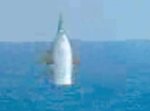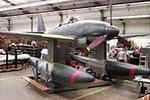Navigation
Install the app
How to install the app on iOS
Follow along with the video below to see how to install our site as a web app on your home screen.
Note: This feature may not be available in some browsers.
More options
You are using an out of date browser. It may not display this or other websites correctly.
You should upgrade or use an alternative browser.
You should upgrade or use an alternative browser.
What the hell is that???
- Thread starter seesul
- Start date
Ad: This forum contains affiliate links to products on Amazon and eBay. More information in Terms and rules
More options
Who Replied?Elvis
Chief Master Sergeant
Its what you call a bad photoshop job.
Someone's superimposed the pic of a jet fighter over a sub based missle launching out of the water.
Elvis
Someone's superimposed the pic of a jet fighter over a sub based missle launching out of the water.
Elvis
ccheese
Member In Perpetuity
Yes.... I think it's BS too. I don't think the wings would stay on being
"launched" underwater.
Charles
"launched" underwater.

Charles
evangilder
"Shooter"
That's been floating around the net for a while, and yes, it is a fake.
Its what you call a bad photoshop job.
Someone's superimposed the pic of a jet fighter over a sub based missle
Elvis
More likely After Effects...
Photoshop gets all the credit!
Matt308
Glock Perfection
After Effects, huh? And I thought all ear swabs were Qtips.
ccheese
Member In Perpetuity
After Effects, huh? And I thought all ear swabs were Qtips.
What is it I am missing here, Matt ?
Charles
Matt308
Glock Perfection
- Thread starter
- #10
seesul
Senior Master Sergeant
For sure it is a fake.Look at these water splashes on its fuselage,please.
Yeas, this is what I´ve noted as well. So good fake
Matt308
Glock Perfection
What is it I am missing here, Matt ?
Charles
Any digital effects on digital photos, irrespective of the computer application, are referred too as having been done by "Photoshop". You know, kind like all ear swabs referred too as "Qtips".
You were expecting an answer right...
ccheese
Member In Perpetuity
Matt: I understand perfectly..... like all tissues are "Kleenex" and all
copiers are "Xerox"..... I believe the term is "a household word".
So there !
Charles
copiers are "Xerox"..... I believe the term is "a household word".
So there !
Charles
Dragonsinger
Airman
Only Know of 2 aircraft launched from subs and Wurger will need to confirm the details of the first one. It was an unpowered autogyro towed by a U-Boat to give it long range spotting ability.
The other was one of the British K class boats which carried a seaplane (unknown type) in a deck hanger.
In both cases the sub had to surface and rig the aircraft.
Truth can be totaly wierd
Dragonsinger
The other was one of the British K class boats which carried a seaplane (unknown type) in a deck hanger.
In both cases the sub had to surface and rig the aircraft.
Truth can be totaly wierd
Dragonsinger
Catch22
Major
The Japanese super subs had aircraft as well. Don't know the proper name though, but I'm sure somebody will know.
Elvis
Chief Master Sergeant
Old Wizard
2nd Lieutenant
The Japanese super subs had aircraft as well. Don't know the proper name though, but I'm sure somebody will know.
This from Military History Online:
"Thus began work on the world's first submarine aircraft carrier in January, 1943 and in little more than a year, the largest submarine ever built was launched. With an aircraft hangar and carrying three bombers, it had the ability to travel anywhere on the globe, underwater and undetected, launch an airborne attack, and return home safely. The War Ministry planned to build a fleet of 21 of these monster subs, dubbed "Sen Tokus", and work began on the first one in early 1943 but only three were actually built—I-400, I-401 and I-402. They each displaced 6,560 tons, were 400 feet long (as compared with a typical U.S. sub's length of just over 200 feet) with a surface speed of 19 knots and 6.5 knots submerged. Overall, they were three times the size of an average WWII sub and had a crew consisting of between 144 and 220 men, depending on the mission. As is usual with any new class of vessel, many design flaws required correction and the intricacies of launching aircraft from a surfaced submersible required lots of training. But eventually, within 45 minutes of surfacing, her skilled personnel could break out, assemble, fuel, arm and catapult all three aircraft. The sleek-looking Aichi M6A Seiran bombers had a wingspan of 40 feet and a length of 38 feet. The planes were launched by a 120-foot catapult and were hoisted back aboard by powerful hydraulic cranes. They were stowed in the hanger compartment with floats detached and wings and tails folded. There was even room for a fourth plane if needed."
I saw a documentary about these subs and the underwater search for their remains. They were sunk by the US Navy along with many other Japanese subs after the war. You'd have thought that the US would take one home for display, but they didn't want the folks at home to know that the Japanese did something they couldn't. They are restoring an Aichi M6A Seiran for display though.
This from Military History Online:
"Thus began work on the world's first submarine aircraft carrier in January, 1943 and in little more than a year, the largest submarine ever built was launched. With an aircraft hangar and carrying three bombers, it had the ability to travel anywhere on the globe, underwater and undetected, launch an airborne attack, and return home safely. The War Ministry planned to build a fleet of 21 of these monster subs, dubbed "Sen Tokus", and work began on the first one in early 1943 but only three were actually built—I-400, I-401 and I-402. They each displaced 6,560 tons, were 400 feet long (as compared with a typical U.S. sub's length of just over 200 feet) with a surface speed of 19 knots and 6.5 knots submerged. Overall, they were three times the size of an average WWII sub and had a crew consisting of between 144 and 220 men, depending on the mission. As is usual with any new class of vessel, many design flaws required correction and the intricacies of launching aircraft from a surfaced submersible required lots of training. But eventually, within 45 minutes of surfacing, her skilled personnel could break out, assemble, fuel, arm and catapult all three aircraft. The sleek-looking Aichi M6A Seiran bombers had a wingspan of 40 feet and a length of 38 feet. The planes were launched by a 120-foot catapult and were hoisted back aboard by powerful hydraulic cranes. They were stowed in the hanger compartment with floats detached and wings and tails folded. There was even room for a fourth plane if needed."
There were plans to use them in a raid against the Panama Canal.
"The Seirans were originally prepared for an attack against the Panama canal, but the target was changed to the US Navy anchorage at Ulithi when Japanese Intelligence learned that the US was preparing to invade Japan. The strike force consisted of four aircraft carrying submarines, 2 I-400 class subs with 3 Seiran each and 2 modified AM class submarines with 2 Seirans each. The flotilla put to sea in July 1945, but the war ended before it could complete it's mission. The remaining submarines in the flotilla returned to Japan and surrendered to US forces."
AirToAirCombat.Com: Aichi M6A Seiran in Detail
.
.
Attachments
Catch22
Major
Ah yes. I think I saw the exact show Wizard. On the Discovery Channel was it?
Users who are viewing this thread
Total: 1 (members: 0, guests: 1)


